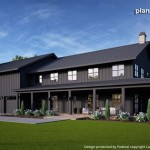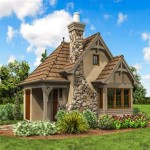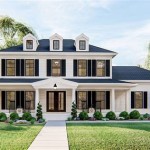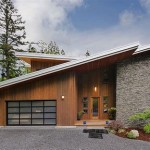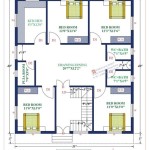House plans with vaulted cathedral ceilings are characterized by their soaring height and dramatic shape. These ceilings are often found in large, grand homes, and they can create a sense of grandeur and spaciousness. Vaulted cathedral ceilings are often made of wood or plaster, and they can be decorated with beams, arches, or other architectural details.
One of the most common examples of a house plan with a vaulted cathedral ceiling is a Tudor-style home. Tudor homes are typically large, rambling houses with steeply pitched roofs and half-timbered exteriors. The interiors of Tudor homes are often characterized by their dark wood paneling, stone fireplaces, and vaulted cathedral ceilings.
In the main body of this article, we will discuss the different types of house plans with vaulted cathedral ceilings, the benefits of vaulted cathedral ceilings, and the challenges of building a house with a vaulted cathedral ceiling.
Vaulted cathedral ceilings are a beautiful and dramatic architectural feature that can add a touch of grandeur to any home. However, there are a few important things to keep in mind when planning a house with vaulted ceilings.
- Height: Vaulted ceilings are typically taller than standard ceilings, so it is important to make sure that the room is large enough to accommodate the extra height.
- Shape: Vaulted ceilings can come in a variety of shapes, including barrel, groin, and ribbed vaults. The shape of the ceiling will affect the overall look and feel of the room.
- Materials: Vaulted ceilings can be made from a variety of materials, including wood, plaster, and drywall. The material used will affect the cost, appearance, and durability of the ceiling.
- Lighting: Vaulted ceilings can be difficult to light, so it is important to plan for adequate lighting. Recessed lighting, chandeliers, and sconces can all be used to illuminate vaulted ceilings.
- Ventilation: Vaulted ceilings can trap heat, so it is important to provide adequate ventilation. Ceiling fans and skylights can help to circulate air and keep the room cool.
- Cost: Vaulted ceilings are more expensive to build than standard ceilings, so it is important to factor in the cost when planning your budget.
- Structural support: Vaulted ceilings require additional structural support, so it is important to work with a qualified builder to ensure that the ceiling is safe and sound.
- Maintenance: Vaulted ceilings can be difficult to maintain, so it is important to be prepared for the additional cost of maintenance.
- Resale value: Vaulted ceilings can add value to a home, but they may not be to everyone’s taste. It is important to consider the resale value of your home when deciding whether or not to install vaulted ceilings.
With careful planning and execution, vaulted ceilings can be a beautiful and dramatic addition to any home. However, it is important to be aware of the challenges involved in building and maintaining vaulted ceilings before making a decision.
Height: Vaulted ceilings are typically taller than standard ceilings, so it is important to make sure that the room is large enough to accommodate the extra height.
The height of a vaulted ceiling is one of the most important factors to consider when planning a house with vaulted ceilings. Vaulted ceilings can range in height from 10 feet to 20 feet or more. The taller the ceiling, the more dramatic the effect will be. However, it is important to make sure that the room is large enough to accommodate the extra height. A vaulted ceiling in a small room can make the room feel cramped and uncomfortable.
- As a general rule, a vaulted ceiling should be at least 10 feet high. This will give you enough headroom to move around comfortably and avoid feeling cramped.
- If you are planning a vaulted ceiling in a large room, you can go even higher. A vaulted ceiling in a great room or living room can be 12 feet or even 14 feet high. This will create a dramatic and spacious feel.
- It is important to consider the height of your furniture when planning a vaulted ceiling. You will want to make sure that your furniture is not too tall or too short for the room. You may also want to consider using furniture with low profiles to avoid making the room feel cluttered.
- If you are not sure how high to make your vaulted ceiling, you can consult with an architect or builder. They can help you determine the right height for your room and your needs.
Vaulted ceilings can add a touch of grandeur and drama to any home. However, it is important to carefully consider the height of the ceiling before making a decision. The right height will create a beautiful and inviting space that you will enjoy for years to come.
Shape: Vaulted ceilings can come in a variety of shapes, including barrel, groin, and ribbed vaults. The shape of the ceiling will affect the overall look and feel of the room.
Barrel vaults
Barrel vaults are the most common type of vaulted ceiling. They are created by arching a single curve over the entire length of the room. Barrel vaults can be either pointed or rounded. Pointed barrel vaults are more common in Gothic architecture, while rounded barrel vaults are more common in Romanesque architecture.
Barrel vaults create a sense of length and movement in a room. They are often used in hallways, corridors, and other long, narrow spaces. Barrel vaults can also be used to create a dramatic effect in a large room, such as a great room or living room.
Groin vaults
Groin vaults are created by intersecting two barrel vaults at right angles. This creates a series of groin lines, which are the lines where the two vaults meet. Groin vaults are often used in large, square rooms. They can also be used to create a more complex and interesting ceiling design.
Groin vaults create a sense of height and grandeur in a room. They are often used in churches, cathedrals, and other large, public buildings. Groin vaults can also be used to create a more intimate and cozy feel in a smaller room.
Ribbed vaults
Ribbed vaults are created by adding ribs to a groin vault. The ribs are usually made of stone or wood, and they help to support the vault and create a more complex and decorative design.
Ribbed vaults are often used in Gothic architecture. They can also be used in other architectural styles, such as Romanesque and Renaissance architecture. Ribbed vaults create a sense of height and drama in a room. They are often used in churches, cathedrals, and other large, public buildings.
Materials: Vaulted ceilings can be made from a variety of materials, including wood, plaster, and drywall. The material used will affect the cost, appearance, and durability of the ceiling.
The material you choose for your vaulted ceiling will depend on your budget, your desired aesthetic, and the climate in which you live. Here are the pros and cons of each material:
- Wood
Wood is a classic choice for vaulted ceilings. It is strong, durable, and can be stained or painted to match any dcor. However, wood is also more expensive than other materials, and it can be difficult to install. Wood is also susceptible to moisture damage, so it is not a good choice for vaulted ceilings in humid climates.
- Plaster
Plaster is a versatile material that can be used to create a variety of looks, from smooth and elegant to rustic and textured. Plaster is also relatively inexpensive and easy to install. However, plaster is not as durable as wood or drywall, and it can be difficult to repair if it is damaged.
- Drywall
Drywall is a lightweight and inexpensive material that is easy to install. Drywall is also fire-resistant and moisture-resistant, making it a good choice for vaulted ceilings in humid climates. However, drywall is not as strong as wood or plaster, and it can be easily damaged by impact.
- Metal
Metal is a durable and fire-resistant material that can be used to create a variety of looks, from industrial to modern. Metal is also relatively easy to install. However, metal is more expensive than other materials, and it can be difficult to work with.
Once you have chosen a material for your vaulted ceiling, you will need to decide on a finish. There are a variety of finishes available, including paint, stain, and wallpaper. You can also choose to leave the ceiling unfinished, which will give it a more rustic look.
Lighting: Vaulted ceilings can be difficult to light, so it is important to plan for adequate lighting. Recessed lighting, chandeliers, and sconces can all be used to illuminate vaulted ceilings.
Vaulted ceilings can be difficult to light because of their height and shape. The light from a single light fixture may not be enough to illuminate the entire ceiling, and the light can be unevenly distributed. To avoid these problems, it is important to plan for adequate lighting when designing a room with a vaulted ceiling.
- Recessed lighting
Recessed lighting is a good option for vaulted ceilings because it can be installed flush with the ceiling, which creates a clean and modern look. Recessed lighting can also be used to create a variety of lighting effects, such as washing the walls with light or highlighting architectural features.
- Chandeliers
Chandeliers are a classic choice for vaulted ceilings. They can add a touch of elegance and drama to a room. Chandeliers are available in a variety of styles, from traditional to modern. When choosing a chandelier for a vaulted ceiling, it is important to select a fixture that is the right size and scale for the room.
- Sconces
Sconces are a good option for providing additional lighting to a vaulted ceiling. Sconces can be mounted on the walls or on the ceiling itself. They can be used to highlight architectural features, such as beams or arches. Sconces can also be used to create a more intimate and cozy atmosphere in a room.
- Natural light
Natural light is the best way to illuminate a vaulted ceiling. If possible, try to design your room with windows that allow natural light to enter from multiple directions. This will help to create a more evenly lit space.
By following these tips, you can create a well-lit vaulted ceiling that is both beautiful and functional.
Ventilation: Vaulted ceilings can trap heat, so it is important to provide adequate ventilation. Ceiling fans and skylights can help to circulate air and keep the room cool.
Ceiling fans
Ceiling fans are a great way to circulate air in a room with a vaulted ceiling. Ceiling fans work by spinning their blades, which creates a flow of air. This flow of air can help to keep the room cool and comfortable, even on hot days. Ceiling fans are also relatively inexpensive to install and operate.
When choosing a ceiling fan for a room with a vaulted ceiling, it is important to select a fan that is the right size for the room. A fan that is too small will not be able to circulate enough air to keep the room cool. A fan that is too large may be too noisy and may not be able to fit in the space properly.
Skylights
Skylights are another great way to provide ventilation in a room with a vaulted ceiling. Skylights allow natural light to enter the room, which can help to brighten the space and make it feel more inviting. Skylights also allow air to circulate, which can help to keep the room cool and comfortable.
When installing skylights in a room with a vaulted ceiling, it is important to choose skylights that are the right size and shape for the room. Skylights that are too small will not allow enough light or air to enter the room. Skylights that are too large may be too heavy for the roof and may not be able to be properly sealed.
Other ventilation options
In addition to ceiling fans and skylights, there are a number of other ways to provide ventilation in a room with a vaulted ceiling. These include:
- Opening windows
- Installing a whole-house fan
- Using an air conditioner
The best way to ventilate a room with a vaulted ceiling will depend on the specific needs of the room and the climate in which you live.
Paragraph after details
Vaulted ceilings can be a beautiful and dramatic addition to any home. However, it is important to provide adequate ventilation in a room with a vaulted ceiling to avoid heat buildup. Ceiling fans and skylights are two great options for providing ventilation in a room with a vaulted ceiling. By following these tips, you can create a well-ventilated room with a vaulted ceiling that is both beautiful and comfortable.
Cost: Vaulted ceilings are more expensive to build than standard ceilings, so it is important to factor in the cost when planning your budget.
The cost of a vaulted ceiling will vary depending on the size of the room, the height of the ceiling, the materials used, and the complexity of the design. However, as a general rule, you can expect to pay more for a vaulted ceiling than you would for a standard ceiling.
- Materials: The materials used to build a vaulted ceiling will have a significant impact on the cost. Wood is the most expensive material, followed by plaster and drywall. Metal is the least expensive material, but it is also the most difficult to work with.
- Labor: The labor costs to build a vaulted ceiling will also vary depending on the complexity of the design. A simple vaulted ceiling will be less expensive to build than a complex vaulted ceiling with multiple curves and angles.
- Size: The size of the room will also affect the cost of the vaulted ceiling. A vaulted ceiling in a large room will be more expensive to build than a vaulted ceiling in a small room.
- Height: The height of the vaulted ceiling will also affect the cost. A taller vaulted ceiling will be more expensive to build than a shorter vaulted ceiling.
In addition to the initial cost of construction, you will also need to factor in the cost of maintenance. Vaulted ceilings can be more difficult to maintain than standard ceilings, so you may need to budget for additional maintenance costs.
Structural support: Vaulted ceilings require additional structural support, so it is important to work with a qualified builder to ensure that the ceiling is safe and sound.
Vaulted ceilings are more complex to build than standard ceilings, and they require additional structural support to ensure that they are safe and sound. The type of structural support required will vary depending on the size, shape, and materials used to build the vaulted ceiling.
For small vaulted ceilings, additional framing may be all that is needed to provide adequate support. However, for larger vaulted ceilings, more substantial structural support may be required, such as steel beams or trusses. It is important to work with a qualified builder to determine the best type of structural support for your vaulted ceiling.
In addition to the structural support provided by the framing and trusses, vaulted ceilings may also require additional support from the walls. This can be achieved by using stronger wall materials, such as concrete or brick, or by adding buttresses or other structural elements to the walls.
By working with a qualified builder, you can ensure that your vaulted ceiling is properly supported and safe for your family and guests to enjoy.
Vaulted ceilings can be a beautiful and dramatic addition to any home. However, it is important to remember that they require additional structural support to ensure that they are safe and sound. By working with a qualified builder, you can create a vaulted ceiling that is both beautiful and safe.
Maintenance: Vaulted ceilings can be difficult to maintain, so it is important to be prepared for the additional cost of maintenance.
Vaulted ceilings are beautiful and dramatic, but they can also be more difficult to maintain than standard ceilings. The height and complexity of vaulted ceilings can make it difficult to reach and clean them, and they may require more frequent repairs. Here are some of the most common maintenance issues associated with vaulted ceilings:
- Dust and dirt accumulation: Vaulted ceilings are high, so they can accumulate a lot of dust and dirt. This can be a problem for people with allergies or respiratory problems. To reduce dust and dirt accumulation, it is important to clean vaulted ceilings regularly. You can use a vacuum cleaner with a long extension wand to reach the high areas of the ceiling. You can also use a damp cloth or mop to wipe down the ceiling.
- Cobwebs: Vaulted ceilings are also a favorite place for spiders to build webs. Cobwebs can be unsightly and they can also trap dust and dirt. To remove cobwebs, you can use a broom or a vacuum cleaner with a cobweb attachment. You can also use a damp cloth or mop to wipe down the ceiling.
- Water damage: Vaulted ceilings are more susceptible to water damage than standard ceilings. This is because the high ceilings can make it difficult to detect leaks in the roof. If water does leak onto a vaulted ceiling, it can cause the ceiling to sag or collapse. To prevent water damage, it is important to inspect your roof regularly for leaks. You should also make sure that your gutters and downspouts are clean and in good working order.
- Structural problems: Vaulted ceilings are more complex to build than standard ceilings, so they are more likely to develop structural problems. These problems can include cracks in the ceiling, sagging, and even collapse. If you notice any structural problems with your vaulted ceiling, it is important to contact a qualified contractor immediately.
By following these tips, you can help to keep your vaulted ceiling looking its best and prevent costly repairs. However, it is important to be aware of the potential maintenance issues associated with vaulted ceilings before you decide to install one in your home.
Resale value: Vaulted ceilings can add value to a home, but they may not be to everyone’s taste. It is important to consider the resale value of your home when deciding whether or not to install vaulted ceilings.
### Paragraph 1:Vaulted ceilings can add value to a home by making it feel more spacious and luxurious. This can be a major selling point for potential buyers, especially those who are looking for a home with a unique and dramatic look. However, it is important to keep in mind that vaulted ceilings may not be to everyone’s taste. Some people may prefer a more traditional look with a standard ceiling height. If you are considering installing vaulted ceilings, it is important to research the local real estate market to see if this feature is likely to add value to your home.### Paragraph 2:In some cases, vaulted ceilings can actually decrease the resale value of a home. This is especially true if the vaulted ceilings are not well-executed. For example, vaulted ceilings that are too high or too narrow can make a room feel cramped and uncomfortable. Vaulted ceilings that are not properly supported can also be a safety hazard. If you are considering installing vaulted ceilings, it is important to work with a qualified contractor to ensure that they are designed and built properly.### Paragraph 3:If you are planning to sell your home in the near future, it is important to consider the resale value of your home when making decisions about renovations. If you are not sure whether or not vaulted ceilings will add value to your home, it is best to err on the side of caution and stick with a more traditional ceiling height.### Paragraph 4:Ultimately, the decision of whether or not to install vaulted ceilings is a personal one. If you love the look of vaulted ceilings and are willing to invest in their upkeep, then they can be a great addition to your home. However, if you are concerned about the resale value of your home or are on a tight budget, then it may be best to stick with a more traditional ceiling height.










Related Posts


